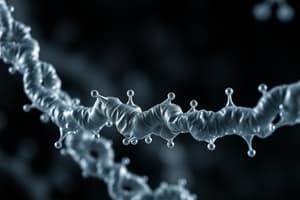Podcast
Questions and Answers
What is the primary function of nucleic acids like DNA and RNA?
What is the primary function of nucleic acids like DNA and RNA?
- Storing and transmitting genetic information (correct)
- Creating cell membranes
- Acting as biological catalysts
- Determining protein structure
How do lipids contribute to cell structure?
How do lipids contribute to cell structure?
- By acting as biological catalysts
- By storing and transmitting genetic information
- By forming lipid bilayers in cell membranes (correct)
- By determining protein functions
What is the role of enzymes in living organisms?
What is the role of enzymes in living organisms?
- Storing genetic information
- Creating lipid bilayers in cell membranes
- Speeding up chemical reactions as biological catalysts (correct)
- Serving as messengers between DNA and proteins
Which biomolecules have unique structures that enable them to store and transmit genetic information?
Which biomolecules have unique structures that enable them to store and transmit genetic information?
In what way does DNA impact the functions of living organisms?
In what way does DNA impact the functions of living organisms?
Explain the significance of the order of amino acids in a protein.
Explain the significance of the order of amino acids in a protein.
Describe the main functions of carbohydrates in living organisms.
Describe the main functions of carbohydrates in living organisms.
How do lipids contribute to the formation of cell membranes?
How do lipids contribute to the formation of cell membranes?
Explain the roles of nucleic acids in storing genetic information.
Explain the roles of nucleic acids in storing genetic information.
Discuss the various functions of proteins in living organisms beyond enzymatic activities.
Discuss the various functions of proteins in living organisms beyond enzymatic activities.
Study Notes
Exploring Biomolecules: A Guide to Proteins, Lipids, Carbohydrates, Enzymes, and Nucleic Acids
Biomolecules are the organic compounds that form the foundation of life, driving processes that range from energy storage and structural support to genetic information and catalysis. In this article, we'll dive deeper into the four major types of biomolecules—proteins, lipids, carbohydrates, and nucleic acids—as well as enzymes and their role in facilitating essential biological functions.
Proteins
Proteins are large, complex molecules made up of amino acids, which are linked together by peptide bonds. They serve diverse roles, including as structural components of cells, enzymes, transporters, hormones, and antibodies. Proteins can fold into an almost infinite variety of shapes, each form corresponding to a unique function.
Lipids
Lipids are a diverse group of hydrophobic molecules, primarily involved in energy storage and cell membrane formation. They include triglycerides, phospholipids, cholesterol, and steroids. Lipid bilayers, composed of phospholipid molecules, create the structure of cell membranes and organelles.
Carbohydrates
Carbohydrates are organic molecules composed of carbon, hydrogen, and oxygen, and are the most abundant biomolecules on Earth. They serve as energy sources and as structural components. Monosaccharides, disaccharides, oligosaccharides, and polysaccharides are types of carbohydrates, with each having a specific function in biological systems.
Nucleic Acids
Nucleic acids, including DNA and RNA, are polymeric molecules that store and transmit genetic information. In DNA, the sequence of nucleotides determines the amino acid sequence of proteins, which in turn dictate the functions of living organisms. RNA serves as a messenger between DNA and proteins and can also act as a catalyst in some cellular processes.
Enzymes
Enzymes are proteins that act as biological catalysts, speeding up chemical reactions in living organisms. They are essential for life as they enable organisms to perform a wide range of biological processes.
The structure and function of biomolecules are closely interconnected. For example, the hydrophobic nature of lipids leads to the formation of lipid bilayers, which in turn create the structure of cell membranes. Enzymes have a specific shape that allows them to fit and interact with their substrates. DNA and RNA are complex molecules with unique structures that enable them to store and transmit genetic information.
Understanding biomolecules and their roles in life is essential for the advancement of biology, medicine, and biotechnology. By exploring the structure and function of these complex molecules, we can continue to gain insights into the inner workings of living organisms and develop new tools for improving human health and well-being.
Studying That Suits You
Use AI to generate personalized quizzes and flashcards to suit your learning preferences.
Description
Dive deeper into the world of biomolecules by learning about proteins, lipids, carbohydrates, enzymes, and nucleic acids. Understand their structures, functions, and roles in essential biological processes.




